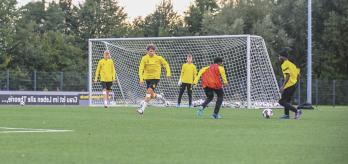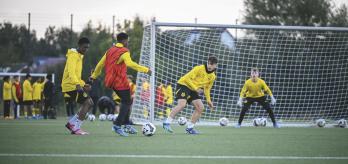The session starts with an activation drill based on the idea of hunting the ball down at speed. In this exercise, which is played 6 plus 2 v6, the defensive emphasis is on getting the back four to shift across and push up effectively. By contrast, players in possession are encouraged to focus on play in the final third; moving the ball quickly is the key to creating chances. The drill is followed by an exercise about defending against one-twos – a situation that is bound to occur frequently when playing a high press. The key point here is to engage the opponent and to be strong in the challenge. In the final exercise, players get the opportunity to implement the coaching points dealt with during the session in a relatively large space and in a representative, match-like 8v8 scenario, thus allowing them to hone their skills.
Session overview
Part 1: 4v1 in four squares
The session starts with an intense exercise that’s all about hunting down the ball. It is played 4v1 in four squares to encourage aggression in defence and quick transitions.
-
Divide a 16m x 16m playing area into four squares, and set up a “waiting room” with a pole in the centre of the playing area.
-
Choose 3-4 defenders (shown here in orange).
-
Place 4 attackers in each square.
-
Start by playing 4v1 in one of the squares.
-
Once three consecutive passes have been completed, the blue team can move into one of the other squares.
-
As they do so, a new defender sprints out from the “waiting room” into the 4v1.
-
After a while, swap the players’ roles.
-
The team in possession should prepare before they switch play.
-
Players who are in a different square to the ball should be proactive in showing for the ball so their team-mates can switch the play.
-
The passing team should make the most of their numerical advantage through good positioning.
- Defenders in the middle must hold on to a pole to ensure they do not get a head start.
-
The defending players should keep the intensity up and hunt down the ball.
-
Anticipating passes is key.
-
The defending players should put their opponent under pressure.
Part 2:5v5 plus goalkeepers plus 2
From a defensive point of view, the second exercise focuses on the back four moving across and engaging the opposition. For the attacking side, this drill is all about play in the final third, as they look to shift the ball quickly to create dangerous scoring opportunities.
-
In a 32m x 50m playing area, mark out a 5m-wide channel on either side of the pitch. Then position a goal and a goalkeeper at each end of the playing area.
-
Form two teams of 10 players (including goalkeepers) and choose 2 players to be neutrals.
-
4 players in each team sit out each time.
-
The goalkeepers also rotate.
-
The exercise is played 6+2v6. The offside rule applies.
-
The neutral players can take as many touches as they like, and can move into the centre of the playing area as the situation demands.
-
If a goal is scored or the ball goes out of play, play restarts from the goalkeeper.
-
Once you have gone through the drill three times, bring on the players waiting on the sidelines.
-
Begin play with a high pass from behind the goal to engage the players in an aerial duel.
-
Encourage the defending team’s back four to shift across quickly and push up to engage the opposition.
-
The team in possession should switch play swiftly to create chances.
Part 3: Defending one-twos in different areas
This exercise is all about defending against one-twos. Success depends on engaging the attacker and being strong when you need to be.
-
Mark out two 15m x 15m playing areas and set up two mini-goals as shown.
-
In each of the playing areas, divide 10 players into 2 teams and position them at points A, B, C and D as shown in the illustration.
-
A teams up with B for a 2v1 against C. A and B try to get over the goal line at the opposite end of the playing area.
-
A passes the ball to B, who lays it off.
-
C turns towards A and looks to defend against the one-two.
-
C then teams up with D to go 2v1 against A.
-
A dribbles towards C and passes to B. B passes the ball back to A with one touch.
-
C turns towards A and defends against the one-two. If they win the ball, they then try to finish.
-
Afterwards, a player from position C teams up with a player from position D, and they go 2v1 against A.
-
As A passes to B, C should turn towards A and look to make physical contact with them, thus slowing the attacker down. Ideally, C should try to get their body between the ball and their opponent.
-
C should hold off A and seek to intercept the pass so as to end up in possession in space.
-
Ensure proper positioning to turn quickly and accelerate to intercept the one-two.
Part 4: 5v4 plus goalkeepers plus 1 and 2v1
This drill centres on a high press. The attacking team are expected to work hard to progress the ball quickly and directly towards goal. If the direct route to goal is blocked, the team in possession should switch the play to the other side of the pitch as fast as possible in order to change the angle of attack and exploit space.
-
Divide up a 35m-long playing area as shown in the illustration. Then position three goals, each guarded by a goalkeeper, as shown.
-
Form a red team of 10 players (including the goalkeeper) and a blue team of 12 players (including 2 goalkeepers).
-
Nominate 1 neutral player (shown in yellow).
-
Position 6 attackers (shown here in blue), 5 defenders (shown here in red) and the neutral player around the playing area as shown.
-
The blue team start with the ball in one half of the playing area and try either to hold on to possession or to get the ball forwards.
-
After 5 passes, the blues can move the ball into the other half of the playing area.
-
The teams then play on in a 9v6 game.
-
If the ball goes out of play or a goal is scored, play should restart from one of the blue goalkeepers.
-
Swap the players around after 2 full sequences.
-
The attacking players should draw the opposition in, look for the overload and exploit it.
-
Decision-making: Timing is key when deciding whether to play the ball forwards quickly or switch the play.
-
The defenders should look to press high and put the attackers under pressure.
-
However, it is important to stay compact when the opposition switch the play.
Part 5: 7 plus goalkeeper v 7(8)
The session finishes with a game of defence v. attack. This exercise is designed to give the squad first-hand experience of how to apply the coaching points in a relatively large space.
-
In one half of a full-size pitch, set up a full-size goal and three mini-goals as shown.
-
Form a red team of 8 players (7 outfielders and a goalkeeper) and a blue team of 8 outfielders.
-
The blues should set up in a 1-2-4-1.
-
The reds should line up in a 4-2-1 formation and defend aggressively.
-
The goalkeepers should take turns in goal.
-
Play begins with 7 orange players opposing 7 blue players. The blue holding midfielder remains passive outside the playing area.
-
When blue initiates a new attack, the blue holding midfielder joins the game, creating an 8v7 plus goalkeeper situation. Orange now defends with numerical inferiority
-
After a while, swap the players over.
-
The players are encouraged to apply the coaching points from the previous exercises in a game environment.

















